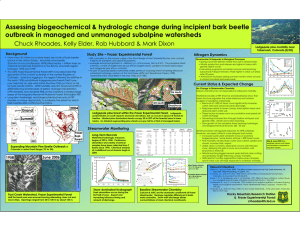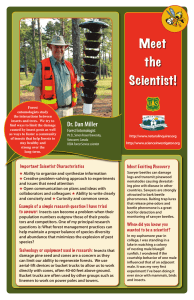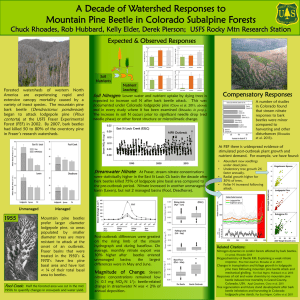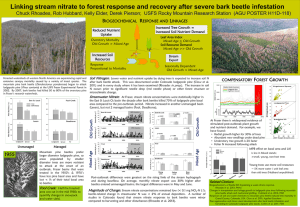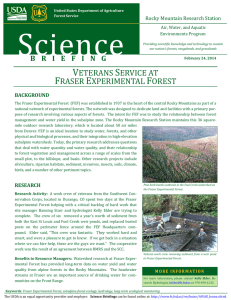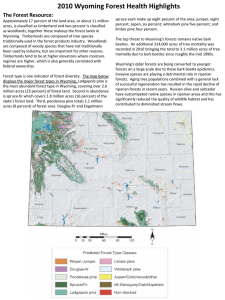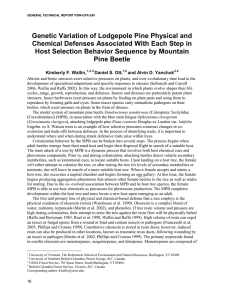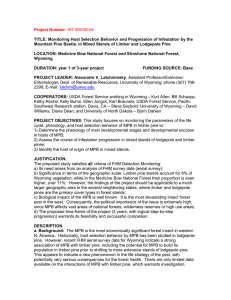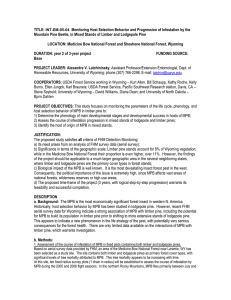Streamwater Nitrogen During Mountain Pine Beetle Infestation of Subalpine Watersheds
advertisement
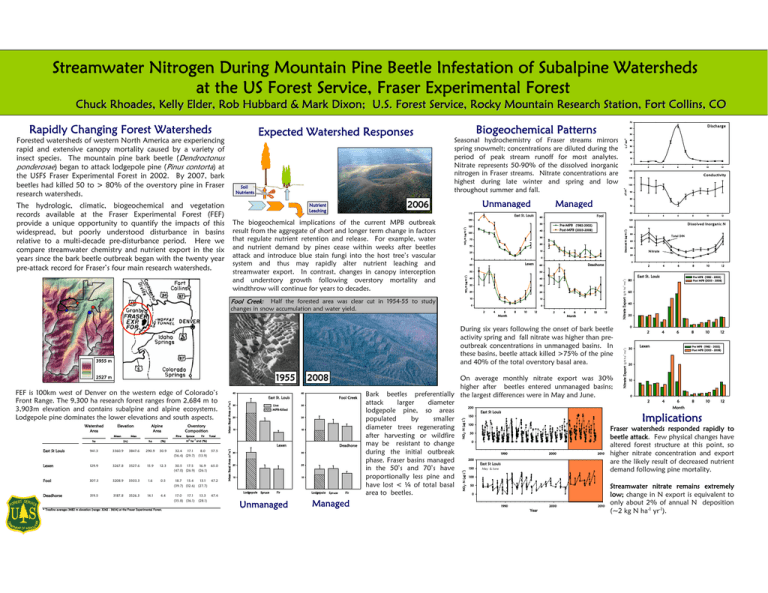
Streamwater Nitrogen During Mountain Pine Beetle Infestation of Subalpine Watersheds at the US Forest Service, Fraser Experimental Forest Chuck Rhoades, Kelly Elder, Rob Hubbard & Mark Dixon; U.S. Forest Forest Service, Rocky Mountain Research Station, Fort Collins, CO Unmanaged 175 50 Max (m) Overstory Composition Pine ha (%) Spruce Fir 20 20 10 10 Total m2 ha -1 and (%) 290.9 30.9 32.4 17.1 (56.4) (29.7) 8.0 (13.9) 57.5 Lexen 129.9 3267.8 3527.6 15.9 12.3 30.5 17.5 (47.0) (26.9) 16.9 (26.1) 65.0 307.3 3208.9 3503.3 1.6 0.5 18.7 15.4 13.1 (39.7) (32.6) (27.7) 47.2 Deadhorse 319.5 3187.8 3526.3 14.1 4.4 17.0 17.1 (35.8) (36.1) 47.4 * Treeline averages 3482 m elevation (range: 3242 - 3654) at the Fraser Experimental Forest. 13.3 (28.1) Mean Basal Area Fool Deadhorse 30 30 20 20 10 10 Lodgepole Spruce Fir Unmanaged Lodgepole -2 -1 L s km -1 μS cm 2 10 Spruce Fir Managed 4 6 8 10 12 Dissolved Inorganic N 80 Total D IN 60 40 N itrate 0 Lexen 0 Deadhorse 60 2 4 30 20 20 10 10 6 8 10 12 2 4 6 8 10 12 Month Nitrate Export 4 8 10 12 Pre MPB (1982 - 2002) Post MPB (2003 - 2008) 60 40 20 0 2 -1 0 2 80 East St. Louis -1 -1 40 30 (g N ha mo ) 40 6 M onth 50 0 30 Lexen 4 6 8 10 12 Pre MPB (1982 - 2002) Post MPB (2003 - 2008) 20 On average monthly nitrate export was 30% 10 higher after beetles entered unmanaged basins; Bark beetles preferentially the largest differences were in May and June. 0 2 4 6 8 10 12 attack larger diameter 200 Month lodgepole pine, so areas East St Louis 150 populated by smaller 100 diameter trees regenerating Fraser watersheds responded rapidly to 50 after harvesting or wildfire beetle attack. Few physical changes have 0 may be resistant to change altered forest structure at this point, so during the initial outbreak 1990 2000 2010 higher nitrate concentration and export 200 phase. Fraser basins managed are the likely result of decreased nutrient East St Louis 150 May & June in the 50’s and 70’s have demand following pine mortality. 100 proportionally less pine and 50 have lost < ¼ of total basal Streamwater nitrate remains extremely 0 area to beetles. low; change in N export is equivalent to only about 2% of annual N deposition 1990 2000 2010 Year (~2 kg N ha-1 yr-1). -1 3847.6 -1 3360.9 2 941.3 (m ha ) Lexen East St Louis 90 60 20 50 50 -1 2 -1 (m ha ) Fool Creek 30 12 20 NO3- N (μg L ) Mean ha Alpine Area Live MPB-Killed 30 10 Conductivity 100 30 75 0 NO3- N (μg L ) Elevation East St. Louis Mean Basal Area Watershed Area 2008 40 8 100 Nitrate Export 1955 6 70 During six years following the onset of bark beetle activity spring and fall nitrate was higher than preoutbreak concentrations in unmanaged basins. In these basins, beetle attack killed >75% of the pine and 40% of the total overstory basal area. 40 4 80 Pre-MPB (1982-2002) Post-MPB (2003-2008) 40 100 Month FEF is 100km west of Denver on the western edge of Colorado’s Front Range. The 9,300 ha research forest ranges from 2,684 m to 3,903m elevation and contains subalpine and alpine ecosystems. Lodgepole pine dominates the lower elevations and south aspects. 2 110 -1 125 25 Half the forested area was clear cut in 1954-55 to study changes in snow accumulation and water yield. 2527 m 0 120 60 Fool Creek: 3955 m 10 Fool 60 -1 The biogeochemical implications of the current MPB outbreak result from the aggregate of short and longer term change in factors that regulate nutrient retention and release. For example, water and nutrient demand by pines cease within weeks after beetles attack and introduce blue stain fungi into the host tree’s vascular system and thus may rapidly alter nutrient leaching and streamwater export. In contrast, changes in canopy interception and understory growth following overstory mortality and windthrow will continue for years to decades. East St. Louis 30 120 Managed 150 40 20 Dissolved N (μg N L ) 2006 Nutrient Leaching NO3-N (μg N L ) The hydrologic, climatic, biogeochemical and vegetation records available at the Fraser Experimental Forest (FEF) provide a unique opportunity to quantify the impacts of this widespread, but poorly understood disturbance in basins relative to a multi-decade pre-disturbance period. Here we compare streamwater chemistry and nutrient export in the six years since the bark beetle outbreak began with the twenty year pre-attack record for Fraser’s four main research watersheds. 50 -1 Soil Nutrients D ischarge 60 Seasonal hydrochemistry of Fraser streams mirrors spring snowmelt; concentrations are diluted during the period of peak stream runoff for most analytes. Nitrate represents 50-90% of the dissolved inorganic nitrogen in Fraser streams. Nitrate concentrations are highest during late winter and spring and low throughout summer and fall. -1 Forested watersheds of western North America are experiencing rapid and extensive canopy mortality caused by a variety of insect species. The mountain pine bark beetle (Dendroctonus ponderosae) began to attack lodgepole pine (Pinus contorta) at the USFS Fraser Experimental Forest in 2002. By 2007, bark beetles had killed 50 to > 80% of the overstory pine in Fraser research watersheds. 70 Biogeochemical Patterns (g N ha mo ) Expected Watershed Responses NO3-N (μg N L ) Rapidly Changing Forest Watersheds Implications

